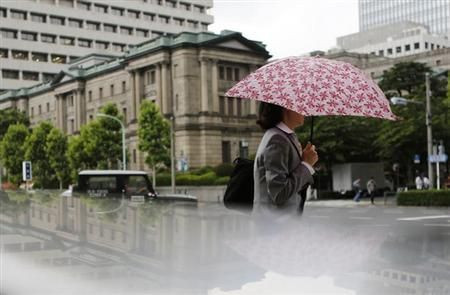BOJ Keeps Policy Steady, Markets Await New Price Forecasts

(Reuters) - The Bank of Japan kept monetary policy steady on Wednesday and is set to lay out projections underscoring its conviction that inflation will head steadily towards its 2 percent target, suggesting no additional stimulus is on the near-term horizon.
However, Governor Haruhiko Kuroda is likely to remind markets that the central bank is ready to ease policy further if weakness in exports or the pain from a sales tax hike prove much worse than expected and threaten to derail the inflation goal.
Industrial production rose a less-than-expected 0.3 percent in March and manufacturers expect output to slide in April, data showed on Wednesday, a sign the recovery in the world's third-largest economy remains fragile.
As widely expected, the BOJ maintained its pledge to increase base money, its key policy gauge, at an annual pace of 60 trillion to 70 trillion yen ($588-$686 billion).
In a closely-watched semiannual outlook report due later on Wednesday (2 a.m. EDT), the BOJ is likely to project consumer inflation will accelerate this year and stay around 2 percent for at least two years from the middle of 2015, sources have told Reuters, reflecting a moderate recovery in the economy.
Such upbeat projections may solidify a growing market consensus that the BOJ will stand pat on policy until July or even longer, as it awaits more data for clues on how the economy has weathered the sales tax hike that was implemented this month.
"The BOJ will stress that companies are smoothly passing on the costs of the sales tax hike to consumers, and that this is because of strong demand," said Masaaki Kanno, chief Japan economist at JPMorgan Securities.
UPBEAT OUTLOOK INTACT
The BOJ has stood pat since offering an intense burst of monetary stimulus in April last year, when it pledged to double base money to accelerate inflation to 2 percent in roughly two years via aggressive asset purchases.
The increase in the national sales tax - to 8 percent from 5 percent - has sparked worries that consumers will tighten their wallets, threatening the economic recovery Prime Minister Shinzo Abe has engineered with aggressive monetary and fiscal stimulus.
The BOJ, however, remains optimistic that the economy can withstand the pain without additional stimulus. It also sees a tightening job market leading to higher wages that will help accelerate inflation towards its price target.
Indeed, total wages rose 0.7 percent in the year to March to mark the first increase in three months, although regular pay fell for the 22th straight month in a sign firms are hesitant yet to increase fixed personnel costs.
Core consumer inflation in Tokyo, a leading indicator of national trends, jumped to a 22-year high of 2.7 percent in April in a sign that companies are making progress in passing on the tax increase to consumers.
When stripping out the effect of the higher levy, Tokyo core consumer prices rose 1 percent year-on-year in April, roughly in line with the BOJ's projection that inflation will hover around 1-1.5 percent until around the middle of the year.
Reflecting the growing optimism, the BOJ is seen roughly maintaining its projections made three months ago that core consumer inflation will hit 1.3 percent in the current fiscal year to March 2015 and accelerate to 1.9 percent the following year, excluding the effect of the tax hike.
In projections for fiscal 2016, to be issued for the first time, the central bank is expected to forecast core consumer inflation will reach or slightly exceed 2 percent, sources have said, signaling it remains confident its price target will be achieved for a sustained period of time.
The BOJ issues its long-term economic and price forecasts in a semiannual report produced in April and October of each year. It reviews the projections in January and July of each year.
© Copyright IBTimes 2025. All rights reserved.





















